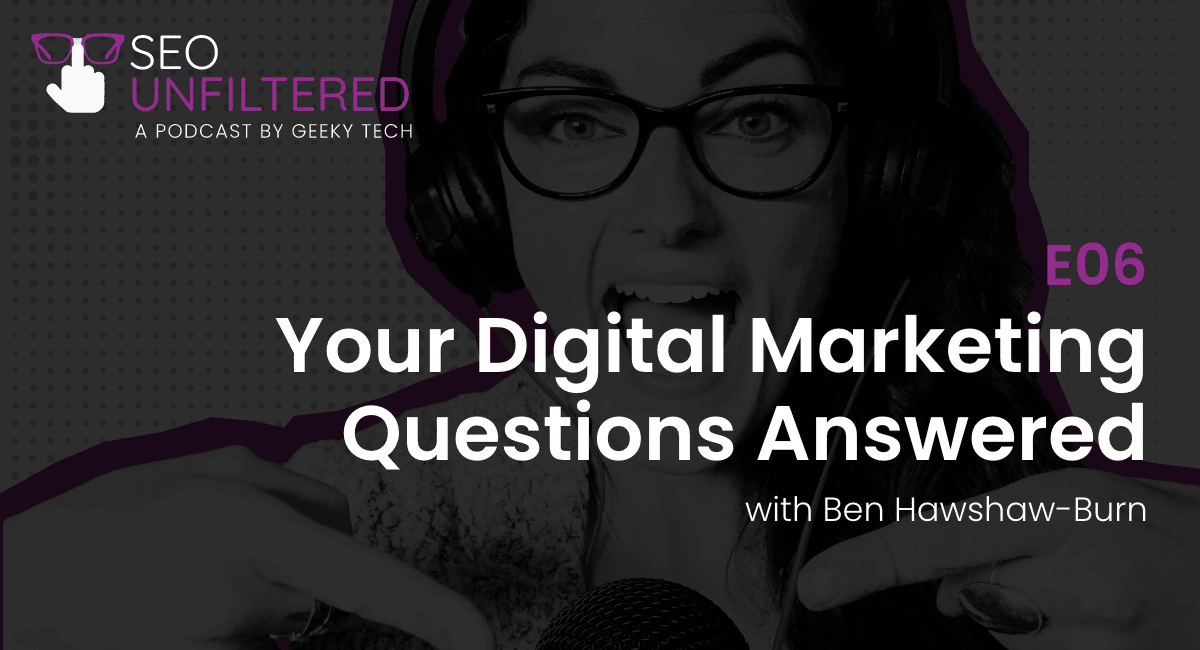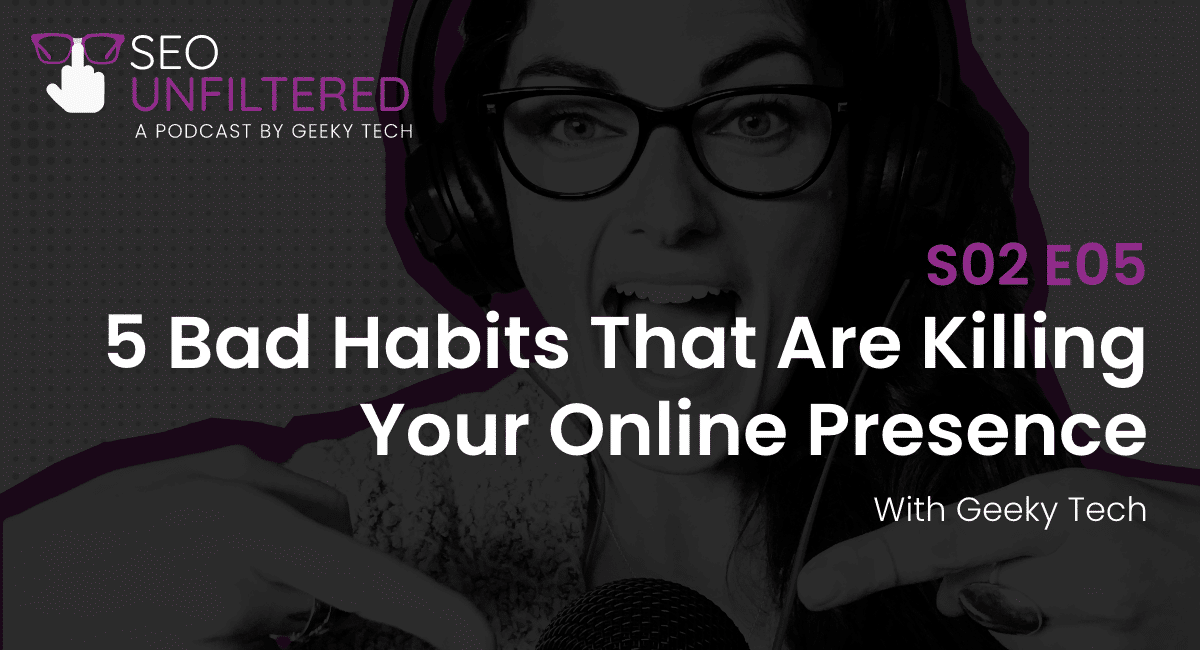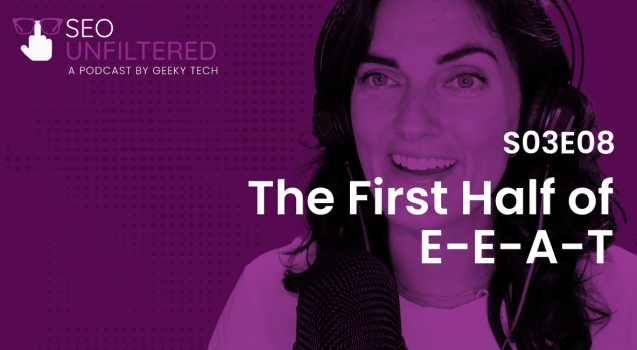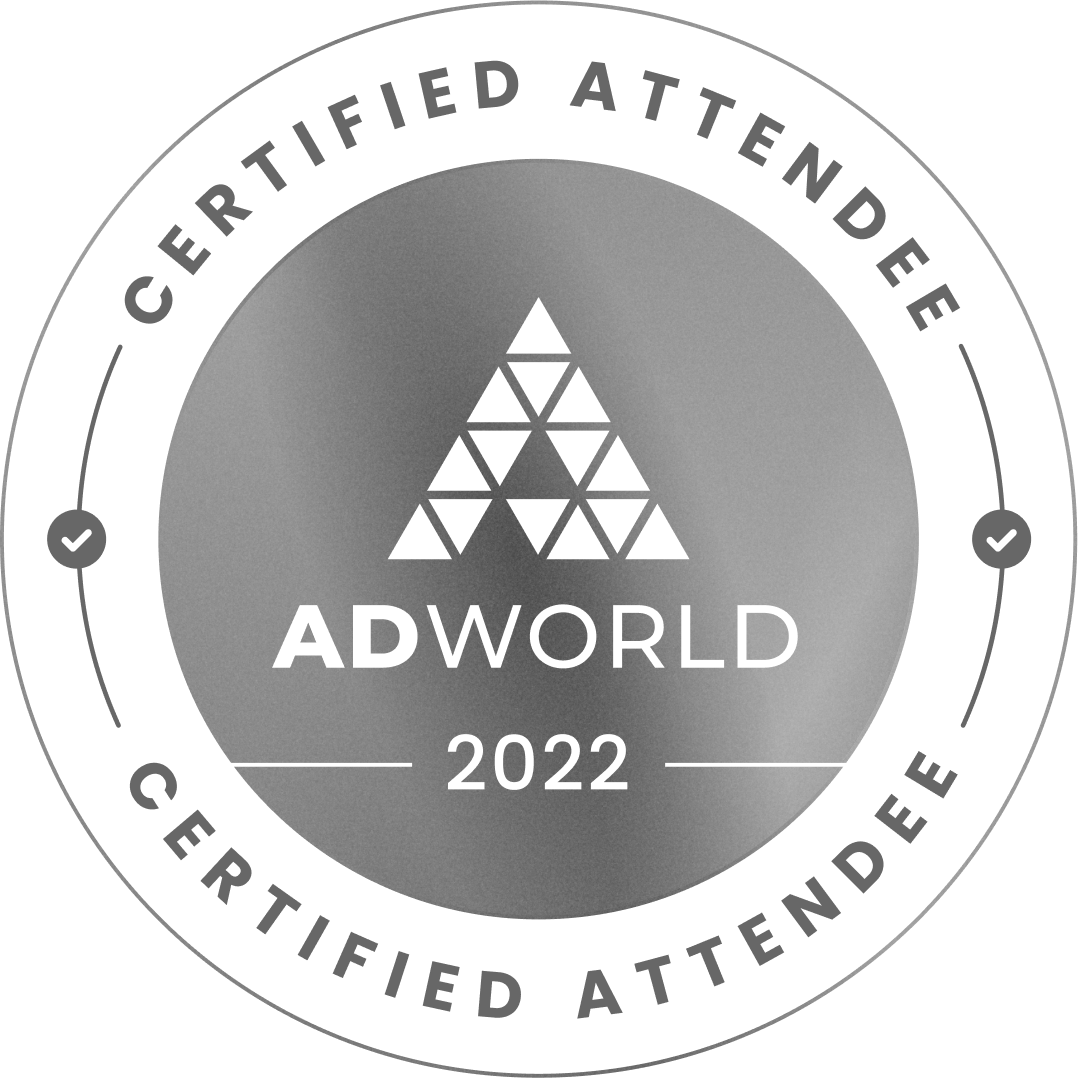Transcript
[00:00:00] Genny: Hey marketers, how’s it going? It’s March here—the month of New beginnings, of growth of fresh starts, and if you’re anything like my grandmother of spring cleaning (yay). While usually defined as a domestic event in which a family’s entire house is given a surgical clean, I believe that the spirit of spring cleaning can be carried into other parts of our lives.
Maybe it’s time to purge your friend list on Facebook, or maybe it’s the right month to go through your desktop and finally organize all those vacation photos that have been floating around in various folders since the time people actually printed their photos. As an indispensable member of a marketing team, you could consider spring cleaning as a way of rid yourself and your team of bad marketing and website practice.
There’s no better time to take a hard look at your site, your department, and your brand, and make a commitment to not be satisfied with the old ways of doing things just because they’re familiar. I’m not saying that fixing these problems will give you better rankings overnight, but I am saying that all of it will pay off one way or another.
I’ve asked some friends to help me along on this journey today as I am merely a marketing messenger, and when it comes to seo, I’d rather hear it from the horse’s mouth. So let’s get started with bad practice number one, which. Putting off your content until later. Where’s your content? Yo. Whether you’ve been putting off hiring an agency or you’ve taken it upon yourself to create key word rich pages, there’s a reason your website doesn’t have new pages to index.
What is that reason? We’ve seen this happen so many times before. You have too many more important fires to put out, and it’s too much of a brain drain, and you’re not confident about your writing skills, and you want it to sound perfect and you haven’t quite figured out your overall marketing strategy.
So you don’t know what your CTA should be, and you’re still looking for content writers. Or maybe just rather your marketing agency, focus on things that’s going to drive more traffic to your site, like ads or social media campaigns or creating mailing lists or fixing site speed. Dude, why do we focus so much of our energy on content?
Is it just to make it look like your site is still alive? Is it just to stay relevant? Is it to make your team look intelligent, topical, and on the. Well, yeah, but it’s also a direct conversation with search queries, which is pretty much the whole point of search engine optimization. If you’ve hired an SEO agency, but content isn’t getting regularly published on your site, you’re wasting your money, and more importantly, missing out on potential growth.
So whatever the reason for these content bottlenecks, I urge you to nip this bad habit in the bed this spring just to drive home this point even further. Ben to help explain the importance of content creation. So, Ben, why is content procrastination such a bad marketing habit?
[00:02:34] Ben: I suppose the main reason that procrastinate on content is a bad marketing habit is because it’s a almost a guaranteed way to not be able to get any kind of SEO results. The simple fact is that if you are not putting words onto your website, you are not entering any kind of new SEO races. So if you think you’ve got a five page brochure website, or a, even if it’s a 50 page brochure website, if you’re not adding any new words, Onto that website, then you are not giving Google the opportunity to see you as relevant for any new, um, you know, keyword races.
And that’s the ultimate goal at kind of driving MQL and SQL, is you need that continual flow. Of relevant traffic. So you need to continually be talking about the same things, engaging the same customers, uh, in the same conversations, excuse me, that your customers are engaged in.
[00:03:29] Genny: Can you rely on your existing content to, to stay in the race for the keywords that you’re already, um, ranking for rr is there a risk that it’s your content’s so old that it’ll just get pushed down the—.
[00:03:45] Ben: I suppose like with every SEO answer that depends , um, if a lot of it comes down to the competition. So if it’s a very, um, if it’s a low search volume, low competition term, um, mm-hmm , you might, you might be able to get away with writing a piece of content that doesn’t need changing or updating for years and years and years to come.
Um, whereas if you are talking about a keyword word or you, you know, again, if we imagine them as they’re like races almost. If you imagine a race where it’s a very competitive race, there’s lots of changes within the industry. Um, you know, regulations, et cetera, then that’s something that you might need to keep updated a lot more regularly.
Um, and also if it’s a very competitive race, something else that you’re probably going to need to do is to create supporting content. Um, not necessarily to directly improve the rankings of that specific page, but to show Google that you are an expert on a particular topic. Um, okay. You know, if you, if you enter a race where one of your competitors.
It’s got hundreds and hundreds of pages on a particular topic or around a particular niche. If you then enter that race and you have got one page or two or three pages, you know, it’s, it’s, it makes sense, doesn’t it? Why Google would choose somebody that seems to be more knowledgeable on topic and how Google is understanding their knowledge on that topic is, you know, the way in which that person is, is writing about it on their site.
[00:05:12] Genny: Good to know. So basically what you’re saying is no content, no results.
[00:05:16] Ben: Yeah, pretty much is, is that simple? Um, okay. You know what we often see with, with websites that we review cuz we, we review hundreds of sites on a, on an ongoing basis and quite often someone will create their brochure. So they will, you know, spend a, a while sculpting the services pages to explain what they have to offer.
Um, that’s not always done in a Google friendly way. Um, so, you know, if you, if you. IT support, but you, you know, you name it something that people don’t search, you know, blue Sky Tech Management, um, your IT support page will never receive any traction. Um, and so we see it on a service page level, but then if you then just create that brochure and then do nothing to your site ever, you’re not really giving Google any reason to want to send you, to send you more traffic.
[00:06:10] Genny: Yeah. Yeah, that makes perfect sense. Okay. Good to know. Okay, so I hope everyone has paid attention to that sage advice because Ben’s knowledge has helped technology companies, and I don’t know how many countries achieve their highest ranking potential, but content is only the tip of the iceberg in terms of bad habits that are holding you back.
Let’s put it this way. Think about what makes a child thrive. Feeding your kid on a regular basis is crucial for their survival, but it’s not the only thing. They need to grow big and strong and happy and healthy. If your kid is having trouble seeing. , you don’t give him more food. You take him to the eye doctor.
I mean, well, you do continue to give him more food, but that’s not going to be the solution to their eye problem. You want little Jimmy to be smart and make lifelong friends. Will you send him to school to learn and to socialize? You don’t stuff his face with hamburger Helper and say, there you go. I guess a dead horse I’m kicking here is that you should be taking a holistic approach to brand optimization.
Publishing content on a regular basis is essential, but it’s not the only thing that’s going to help you outrank your toughest competitor. So what other bad habits should we be purging this spring? We should have actually mentioned this one first as it’s the most time sensitive. But how about not setting up your GA four folks?
We’ve covered this over and over again in the last nine months. Because Google is sunsetting universal Analytics in July of this year. In case you forget, Google Analytics four will soon be the only Google Analytics tool available as of July, which means that you will soon no longer be able to track your site traffic using UA or Universal Analytics.
But let’s ask Alan more about this because who better to explain the transition than our own reporting expert
[00:07:48] Alan: UA, as we call it, to save a few syllables, has been around for about 15. So there’s a bunch of different reasons as to why GA4, which is the, the new iteration. So UA is GA3. Okay. And GA4 is a new one.
There’s a bunch of different reasons as to why the move is happening, but the simple answer is it’s 15 years old. And in today’s world, with a new iPhone every six months, it’s not surprising that an analytics platform has to be kept up to date. And because with the nature of analytics, , you can’t be changing.
The goalposts of the whole point of measuring data is that you’re measuring the same type of data this year compared to last year. Mm-hmm. . So you can make accurate comparisons. So if you were updating the analytics platform every six months, you wouldn’t be able to make those accurate comparisons to the the previous data.
So now we’re actually moving a whole lot of platforms. You can’t actually compare GA4 data to UA. Because it’s not the exact same thing, which is why it’s not just an update, it’s a whole migration. Okay. To a different platform. Uh, but then there’s a bunch of other answers as well. Uh, with the prevalence of apps these days, uh, you used to have to have two different properties or two different data streams, and you’d be looking at app traffic okay?
And website traffic separately, when the reality is, if you are, if you’re a marketer, you wanna look at your total traffic. And GA4. The main idea of that is that you can have both an. And a website data coming into one property at the same time. Okay. And looking at everything in its totality, also a bit more privacy conscious with a GDPR and CCPA in terms of not collecting personally.
Okay. Identifiable information. This is the 2023 version of data analytics, whereas Universal Analytics was around from 2005 and it’s a much needed update.
[00:09:36] Genny: Yeah, that makes perfect sense. But why have we been telling people for the past year to start using GA for now before this onset date?
[00:09:44] Alan: When I do reporting calls to customers as an example, I’ll focus on two major metrics or two major date comparisons.
One will be how did we do this month compared to last month? And that’s always useful, but the reality is if you are comparing. Uh, January to December, and if you’re in a B2B market where everyone shuts down for half of December, January is gonna look pretty good. And that’s fine, but it doesn’t mean that things have actually gone really well.
It just means that you’re comparing a a whole month to a partial month. Okay? So that’s one thing you wanna look at. So you also wanna look at the same month or whatever date range you’re looking at the same time the previous year, because obviously then the seasonality. Doesn’t need to be taken into account, but you’re looking at the longer term growth and when you get to setting up your GA four account, you don’t wanna be looking at one month of data and having nothing to compare it to.
Okay. So we’ve been recommending customers to set it up as soon as possible so that when they do actually not only migrate to it, but actually start using it as their primary analytics platform, they’re gonna have both a month on month and a month versus previous year metric to look at, to know how the progress.
[00:10:54] Genny: Okay, so just to be clear, people can use both UA and GA four at the same time.
[00:11:00] Alan: Yeah, that’s what we’ve been doing. For the last nearly a year. Okay, it’s the 31st of July, or the 1st of July, I forget, but it’s July this year. That is the sunset date. Okay. So when that happens, you’ll have to move to GA four because although universal analytics will still exist and then you can access your old data for about a year, it won’t be inputting new.
so you’re gonna have to move. But right now we’ve actually recommended people running both platforms in parallel. Mm-hmm. , just because G four has been changing a lot, so people want to use what they’re comfortable with. Okay. So you don’t wanna try, try and learn a new platform just to find that in six months time it’s changed again.
[00:11:42] Genny: Yeah, true. I just wanted to talk about the whole idea of tracking. Traffic. Either companies don’t seem to understand the value of it, or they don’t know what to do with their data, maybe so they don’t even bother. Does that, that’s true, right? I, I feel like I’ve heard you guys say that before.
[00:12:00] Alan: Oh, it can be.
I mean, we work with a whole host of different types of customers. Some people are very data savvy and some people really aren’t. . Um, the main idea would be you need to track your website traffic and individual metrics within that. So, you know, okay, you can say website traffic as a whole, but there are particular metrics that are more interesting to one type of business than others.
Okay. Uh, wanting a usable example of that would be users or sessions, which is basically people or visits. Uh, if you are, if you are in an online shop, you basically wanna know how many. are coming to your website and how many people are purchasing things. Right? Whereas if you are in a B2B market, which has a much longer lead cycle, it could be a year before someone comes to your website and then actually becomes a customer.
They might visit their website multiple times. So it’s not the amount of people, but the amount of visits to the website that is either more or at least equally as. . Okay. So we would recommend B2B customers to be looking at sessions as the main website traffic metric, and if you’re B2C, you’re probably more interested in users, but that’s just one example where it’s not just website traffic, one key number, there’s, there’s hundreds of numbers you can look at, and it’s just working out which numbers are important to your business to work out that if you are spending X amount on the website and the marketing efforts, what return and investment are you receiving for those, those.
[00:13:23] Genny: That’s really interesting. I didn’t realize that there was a different way of looking at your traffic, depending on if you’re B2B or B2C, but it makes perfect sense.
[00:13:31] Alan: Thank you.
[00:13:34] Genny: So just quickly back to GA4, what can people do if they haven’t switched to um, GA4, but they don’t really know how they kind of need help?
[00:13:43] Alan: Well, the reality is that people will probably have already switched by now, whether they’re aware of it or not. Oh really? And so analytics sent out a warning, which would’ve appeared. as a top banner along Universal Analytics. Okay? For anyone, for every, every property and every account saying that if you didn’t tick a particular box to tell them not to, they would automatically set up a migrated account in GA4 for you.
So take your existing Universal Analytics property, link it to a new GA four account. The issue for us was that cuz we were a, I wouldn’t even call it ahead of the curve, but let’s just say we were organized enough to have set ourselves and every customer up in GA four. They were gonna create new accounts anyway, which would be duplicate accounts.
Okay? So then we had to go through every customer and tick the box and say, please don’t do that. So the reality is, although we don’t have any customers or access to any websites that don’t have a GA four account, I think everyone will migrate across. Now. It would just mean that they’ve got the default settings as opposed to, oh, that’s not good.
Fine for most, but not for all. Uh, the main thing I’d say is if, if you haven’t looked into it yet, they’re the biggest, um, improvement you can make to the default settings if you’ve never set up yourself, is just to go into your property settings. Uh, I think it’s data settings and then data retention automatically it will only be retaining two months worth of data.
Yeah. And then, you only get two options, so you’ll need to basically pick the longer one, which is 14 months. because unless you pick that, you’re not gonna have that year on year data that we discussed earlier. But everyone should be migrated now.
[00:15:20] Genny: Okay. Well that makes me think that maybe not everything is as clear for people just starting out with GA four, because I don’t, it doesn’t seem like it’s, um, a like for like switch, like for example, isn’t there a slight difference in the conversions.
[00:15:39] Alan: Yeah, absolutely. Even though people would have called it conversions in part of the conversation, in Universal Analytics, it was always referred to as goals and goal completions. Okay? And in GA four, it’s called a conversion, which actually is a welcome change because people would refer to goals as general marketing KPIs.
What key, key performance indicators. We say, you know, what are our goals this year? Right? They didn’t necessarily mean how have we set up our convers. in analytics. So it’s a little more specific, but there’s a whole host of changes within names. Too many to go into, to be honest. Everything has a new version of it or a new name.
Okay. Within reason. So even though things like sessions and users, uh, have remained the same, there’s subtle differences in the way they’re measured. Only very subtle, but they’re not gonna be exactly like for like, um, so for example, sessions in Universal analytics would start again at the mid. So if you got to, if you got to midnight on a day, it would start again.
And that doesn’t happen in GA4, so you’re not gonna have the exact home numbers. They should be, let’s say, 95% the same. But don’t, don’t be surprised if there’s, you know, 2001 versus 2020 or something like that. Okay. Um, it says of the disparity in the data, um, and then just the way they call things, uh, The full page, uh, u URL is now called Page Location.
Okay. Uh, you have to get into, and it basically within GA4, there is less data available out of the box in the sense that it, me, it measures way more stuff, but just clicking around, you can’t necessarily access it all. You have to go into the, uh, the exploration area. Oh, and basically let it know. Let them know what you wanna see, and it’s all a.
But before you could just click on, you know, acquisition, let’s look at the different channels. Um, and you could then add secondary dimensions. So you could say, I wanna look at all the organic traffic or all the direct traffic, and then let’s have a look at what country they came from, or what the user gender was or something like that.
Um, it’s not as easy to do that stuff out of the box. You’d just have to go through another area and within that area, that’s the sort of halfway house. Analytics and what’s now called Looker Studio, which was Data Studio previously, which is okay, data visualization. So it’s sort of a halfway house between having all your analytics data, but allowing people to choose how it’s shown, what the metrics are and how it’s visualized.
Okay. So I dunno if in the long run it will put Looker Studio out of a job. Probably not, because it can be, it can be branded and there’s a little more. sort of customization that you can do within Lipper Studio. Right. But it’s a definite step away from what Universal, universal Analytics was like. Okay.
Uh, yeah. I would prepare to be a little bit confused, but change, change isn’t ever friendly, is it? That’s
[00:18:26] Genny: true. But we’ve also created quite a few posts, um, and helpful guides about this. So I will link to that in our show notes.
[00:18:32] Alan: Exactly. And you, they could, they could always re-reach out to the friendly people at Geeky Tech, couldn’t they?
[00:18:36] Genny: Very true. Nice plug.
I guess, if switching to GA4is your only bad habit, you’re probably in pretty good shape considering Google has kind of taken care of that for you. But as Alan said, it’s really important that you go in and customize it. Anyway, there’s lots of information about that in the show notes, so take a look.
This kind of reminds me of the next bad habit that I wanna talk about, and that is basically failure to embrace change. not to throw a truism at you, but technology is moving at lightning speed, guys. It’s incredible what we can do today that we couldn’t do like 10, five or even two years ago. I hate to say this because I’m a sucker for slow living, but you really can’t expect to stay competitive if you’re sticking to the old ways of doing things.
Change is scary, don’t get me wrong. It kind of seems like AI automation and machine learning are all teaming up to take over everyone’s job. Like some Azimovian robot army. Did I say that properly? Azimovian? Anyway, whether it’s fear of becoming redundant or pure laziness or resistance to learning new things or even that kind of existential angst that we all feel when we dare to look down the telescope into the future.
Unfortunately, change is like that. It doesn’t matter if you don’t like it, it exists regardless of your opinion of it. We’ve reached a point where not embracing AI automation and machine learning is going to leave you in the dust while your competitors run laps around you. . Joe and I have already talked quite a bit about AI content and how it’s not exactly SEO friendly at the moment, but there’s so much more AI can do to speed up your productivity at an exponential rate.
Can you even imagine having to send personalized emails to every contact on your list without automation to help you do it? Oh, and for everyone who thinks that AI generated content still isn’t good enough, I mean, obviously that’s going to change. This stuff moves so quickly, it’s only going to get better and probably sooner than you think.
So I wouldn’t rest on that Laurel folks. But if you wanna dive deeper into this topic, check out our last two episodes, because I do grill Joe about this a lot, so let’s not dwell on this too much. Moving on to bad habit number four, which is totally unrelated, but I couldn’t figure out a sexy segue, bad habit number four is not giving your creative team proper branding documentation.
Ugh. I wish we could afford to buy a clip from Family Guy of Peter Griffin going, you know what really grinds my gears? Okay. I can’t do that accent, so I’m just gonna say, you know what really grinds my gears? When we’re getting ready to write content for a client and we ask them to send us their style guide only to be met with something like, Nope, sorry, don’t have one of those.
Like, I know I might be catastrophizing it a bit, but it really does say something about a company’s marketing chops when they don’t have their own branding documents. It’s very. , very weird. Understanding what your company sounds like, looks like and seems like is kind of a big deal, right? Companies should have two style guides, one for designers and one for copywriters, or if not two, then one that combines both of these.
And that style guide should be the foundation from which all digital and physical assets are created. The content style guide includes all the information your copywriters need to create content for the outside world that’s perfectly in line with your brand. It shows writers how your company spells industry terms, which regional spelling variant it uses, and it stands on the Oxford comma.
It ensures that everything you put out there into the world is consistent with your branding. Duh. Brand consistency might not sound like a big deal if sales and expansion are your top priority, but not having a style guide might make your team seem a little bit on the amateur side, which isn’t exactly the best reputation to have if you’re in a competitive industry.
If you’re still not sure what a content style guide is or how to create one, I’ll drop a link in the show notes for you to a blog post. We wrote about this topic last year. Hopefully that’ll help. Anyway, I’ve said my piece with that. That leaves me with just one more bad habit I wanna talk about on this fine spring day, and that is not setting up your tracking.
We’ve discussed tracking in the context of switching to GA four, but now I wanna talk about why that’s so important in the context of PPC. In my mind it’s just smart business sense to set up your tracking so you can figure out if you’re spending your ad budget wisely. But I’m sure Amin, the only media buyer I know, can articulate that point much better than I can.
So, Amin, why is it so bad to rush through or just avoid. developing and documenting your website tagging plan?
[00:22:55] Amine: Good question. In marketing in general, for any, and especially in paid media advertising, if I want to take that aspect of it as, as a good example, is every decision we make in terms of strategy shifts, mm-hmm.
keywords to focus on channels to leverage for which objective lead magnets that are working. Other ads that we need to improve, et cetera. All of that is based out of the data that we are collecting, that we are compiling and. Getting insights from, as in monthly performance reporting, weekly performance check, or any sort of dashboard that will be monitoring for the paid media activity.
And in order to. make all of the decisions go towards the objective of scaling up the results and improving and getting the most out of your ad spend. We need to know that the data is reliable, okay? And that the metrics we are looking at are the correct metrics. For example, if you are a SaaS company for working or providing software, cloud-based software for laboratories, let’s say, mm.
and you’re running a full funnel strategy with, um, one area where you are trying to be future centric. You’re pushing future centric content. You’re, you know, you’re pitching educational content as well and you are doing self-promotion around your brand, et cetera. You’re also doing some maybe dimension organizing webinars for labor.
uh, or sci scientists, technicians, mm-hmm. , maybe also doing email, indirect ads in email called, you know, all of those as a platform will land off your website. A website that is not tagged correctly and a conversion definition that is not defined correctly, will not help you. Assess the performance. That is post-click, that’s what we call the post-click metrics.
Okay? Three click metrics would be impressions, clicks, click rate average, your average cost per click. Um, and you can split that by channel, by add, by placement, by add format, et cetera. But that is only helpful to assess certain performance. , it’s only helpful to tell if your ad is attractive, if you’re reaching a certain percentage of your target audience on a monthly basis, et cetera.
What, what you probably would care more about is once those users are on your website, uh, or any of your platforms, could be your app as well, what are they doing? Are they converting towards that final goal? That is for me, from a marketing perspective, generating MQs or generating demos or generating registrations for your event or your webinar, et cetera.
Okay. And to be able to do that, you need to make sure that first you define what are those conversion actions on my website? Can I put them under multiple categories? Can I organize them by weight or by importance? Or write typology so somebody doesn’t load in a white paper, for example, would have a different weight.
Scoring, if you want to call it. Some advertisers also use scoring to match with what they’re doing on their crm. Mm-hmm. , then somebody who went directly and booked a demo to speak to one of your experts, or one of your experts will welcome them to, um, the actual SaaS product. So those goals are very different.
Depending on your paid media strategy and media plan, you might want to optimize for certain goals on, on certain periods or for other goals on certain periods, or at the more macro level you might want to optimize for all of those. But using different weights or priorities because you know, if you, if you have an attribution system or you’re using even the most basic attribution future that, for example, Google Analytics has, you might know that certain platforms do not generate direct conversions, but generate.
Assisted conversions are part of that journey. Definitely. Users who, for example, would book a demo from your targeting ad might have clicked on your LinkedIn ad or multiple of those first, then engaged with your website from an email that you sent as part of your outreach. Then maybe came back. A newsletter that you have sent.
All of those touch points, you absolutely need to know those and need where they happen to understand the behavior of your target persona once you are, uh, once they are on your website. All of those variables and all of those, all of that data would allow you to basically improve that journey and improve that funnel, uh, for your users and maximize and make sure you, you, you get the exact results that you.
[00:28:19] Genny: And then adjust accordingly if it doesn’t work the way you think it’s gonna work.
[00:28:23] Amine: Yes, of course. And not only adjust accordingly, but be able to put the finger, or where is the drop off? Mm-hmm. and what I need, what do I need to improve?
[00:28:33] Genny: Right. So it just ends up saving you, well, saving you a lot of money on the one hand, so you’re not wasting money on ads that don’t work, or campaigns that don’t work, but also potentially leading to revenue.
[00:28:46] Amine: Right, exactly. And not only just from an ADSD perspective, a website tagging plan would help you get a sense of how all of your digital marketing activity is working together. Yeah. Um, Yeah, so not only paid ads, I’ve taken paid ads as an example, right? Definitely would help you assess how everything is working, what drives more engagement, conversions, what drives more, um, uh, commercial type of engagements.
Let’s say like booking a call or, you know, picking up the phone and clicking on the click to call button from your website. And obviously each user journey is different and each user journey is unique. Uh, but sometimes you tend to find some trends that you can. Rely on to optimize a funnel for, for certain persona.
For example, you might detect that, um, certain job titles would be interested in specific white papers or specific areas, but they won’t necessarily go to, you know, booking a demo or inquiring for a quote. Okay. But other personas, for example, would be more interested about other types of contents, um, and also would be more likely to engage or get in touch with your experts.
And yeah, having everything tag correctly and being able to collect the data and having dashboards as well, is definitely something that, uh, each and every marketer need to, um, need to take very seriously and at least spend some time into obvious. There is a saying, there is a saying in the digital marketing industry that is linked to that judiciary or related to this, uh, it says analysis paralysis.
Uh, so you don’t need to collect thousands and thousands of KPIs and monitors or thousands of KPIs, okay? All around your, uh, funnel strategy. But you need to. You know, at least the basics there and something that would help you explain if something is working great, why is it working? What is working, and how can we scale it up if something is not working?
What are the areas that I need to improve to get more or better return on spend?
[00:31:09] Genny: Is it common that, um, that companies don’t set their tagging up properly?
[00:31:16] Amine: It is common, uh, in some, in some, we’ve, we found it to be more common in some industries more than others, but from our perspective it is just, usually it is just.
Giving this responsibility to the wrong, uh, person. Oh. So even from our perspective, like I said, a good conversion tracking plan or website tagging plan is not necessarily only for paid or for seo or for whoever is doing your, you know, uh, social media management internally, for example. It’s something that is shared and it’s basically the platform where all of those channels are sending them.
So it’s, we found that it’s kind of difficult sometimes for clients to, you know, find. Under which job role this responsibility falls. Oh my God. Yeah. And sometimes when the, when somebody who is not, who doesn’t necessarily understand the importance of, of this aspect, ends up having to play with Google Tag Manager, installing ga, making sure creating events.
Sometimes they don’t even know that you can create certain events or what an event is. They only know about gold conversions. This is basically why we at Geeky Tech, whenever we onboard someone or a new advertiser for paid ads, we start by running an account audit and the very first think we check before anything else on that account.
Audit is the conversion tracking, and if you are, if you are tracking. The correct conversion points or the potential most relevant conversion points correctly. And we see a lot. For example, we’ve, we’ve seen people tracking, booking the demos in their Google Ads platform, as in tracking the click on the button that takes you to the form, which in 2023 you can probably.
any, any sort of, uh, journey or, or user experience that you have planned on your website? Mm-hmm. , even if it doesn’t have a, the classical thank you page that you send users to after the form submit, et cetera. Right? So tracking a button click for such a, an important conversion might lead you to think that you’re not generating.
The results that you are seeing or Google Ads is telling you, and this is one of the comments that we always hear during the onboarding calls when we are gathering information about the, the previous challenges of the advertisers there is that they say, Google says, I’ve generated 100. leads last month, but I’ve only received five form submissions on my email.
Yeah. And it’s all due to that and it’s, it’s bad as well because it sends the wrong signals to the ad platform.
[00:34:15] Genny: What’s the solution here?
[00:34:16] Amine: The solution is usually setting, initiating a, a website. tagging project from scratch. If it’s, if it only needs to be tweaked, that’s fine. It’s not an issue. We usually just get on a call with the client trying to try to understand either, some clients would already have a proper wait or categories for all of their conversion actions on the website.
They might have set up something similar on their crm. Where it says, for example, if a contact downloads this white paper or clicks from one of the newsletters, give them 30 plus 30 in their score, uh, or plus 20 in their score, et cetera, et cetera. They use the scoring in kind of scale there to move leads from one life cycle, like from N MQL to an SQL L.
Let’s say they define, okay, once any contact or MQL reaches 100 in terms of score points, then they’re, they automatically move up to an S, SQL L and they say that it’s hot enough for the, for somebody from our B D R team, for example, to get in touch with them.
[00:35:26] Genny: But from an organizational perspective, if the main reason why they struggle to even get this thing off the ground is that no one knows who’s responsible, what do you suggest people or organizations do?
[00:35:38] Amine: Well, by the way, get help. You can definitely go to an agency and give them just this one project as a one-off. Um, okay. I’m looking to revamp. Website conversion tracking, and especially if you just launched a new website. Something that we also see is that the conversions that are being tracked on the platforms that we work with are still based on like a.
a two years version of the website, that doesn’t exist anymore. Most of those forms are not there anymore. They have been replaced by others, et cetera, and you’re missing out on all of those engagements. Mm-hmm. So you can definitely get in touch with any agency or even a, uh, an, an expert, independent expert, usually pay for the ads.
Can handle this. SEO experts can handle this as well. Mm-hmm. or any, uh, digital marketing agency would be more than happy to help you build a correct or any good website tagging plan that will help take all of your, uh, digital marketing activity then to the next, uh, to the next, uh, level basically. But yeah, ideally you want someone that is involved in marketing or knows and understands.
Yeah, the marketing ecosystem that your website is not just an interface, it’s, it’s your platform where everything you do online lands and it’s your, you know, main salesperson.
[00:37:12] Genny: Yeah. So there you go. My little spring chickens. Thanks for tuning in for another episode of SEO Unfiltered. I wish you listeners all the best for kicking those bad habits in the bud.
I might be tough at first, but I know you can. Don’t forget to subscribe to our podcast so you never miss an episode. And if you have any questions, feedback, or suggestions for future topics, we’d love to hear from you. You can always connect with us on Instagram, Twitter, and Facebook at Geeky Tech Geeks, or find Geeky Tech on LinkedIn.
Thanks again for listening and we’ll see you next month, Geeks.

Show Notes
In this episode of SEO Unfiltered, Genny and her friends talk about giving your website that big spring cleaning that it probably desperately needs. But, in order to do that, we’re going to have to come face to face with our own bad marketing habits.
In case you’re looking for spoilers, here are the five bad habits Genny and the gang talk about on today’s episode:
- Putting off content
- Not setting up your GA4
- Avoiding change (especially when it comes to AI, automation, and machine learning)
- Not having a company style guide
- Not setting up your tagging correctly
Genny then discusses the bad habit of procrastinating on content creation and how it affects search engine optimization. She emphasizes the importance of publishing content regularly and how it directly affects search queries. Genny then talks about the upcoming transition to GA4 and how it will soon be the only Google Analytics tool available.
She brings in Alan, the reporting expert, to explain why Universal Analytics is being replaced and why companies need to start using GA4 before the sunset date. Genny concludes by stressing the importance of tracking web traffic and not ignoring its value.
Also featured in this episode is a cast of furry friends who had plenty to say on the subject (we did our best to edit out their input but sometimes they brought up some pretty good points):
- Oscar “Bad-Ass” Barker
- Kiwi the Toy Destroyer
- Boneca the Snorer
Suggested Readings
Support your fellow marketing geeks! Follow us on Twitter, Facebook, and Instagram @GeekyTechGeeks for all things SEO and advertising related—and while you’re at it, why not subscribe, like, and follow us on Apple Podcasts, Spotify, Stitcher, or wherever you listen to your favourite shows.
Have any questions you want answered on the show? Email us at contact@geekytech.co.uk.
Thanks for listening













